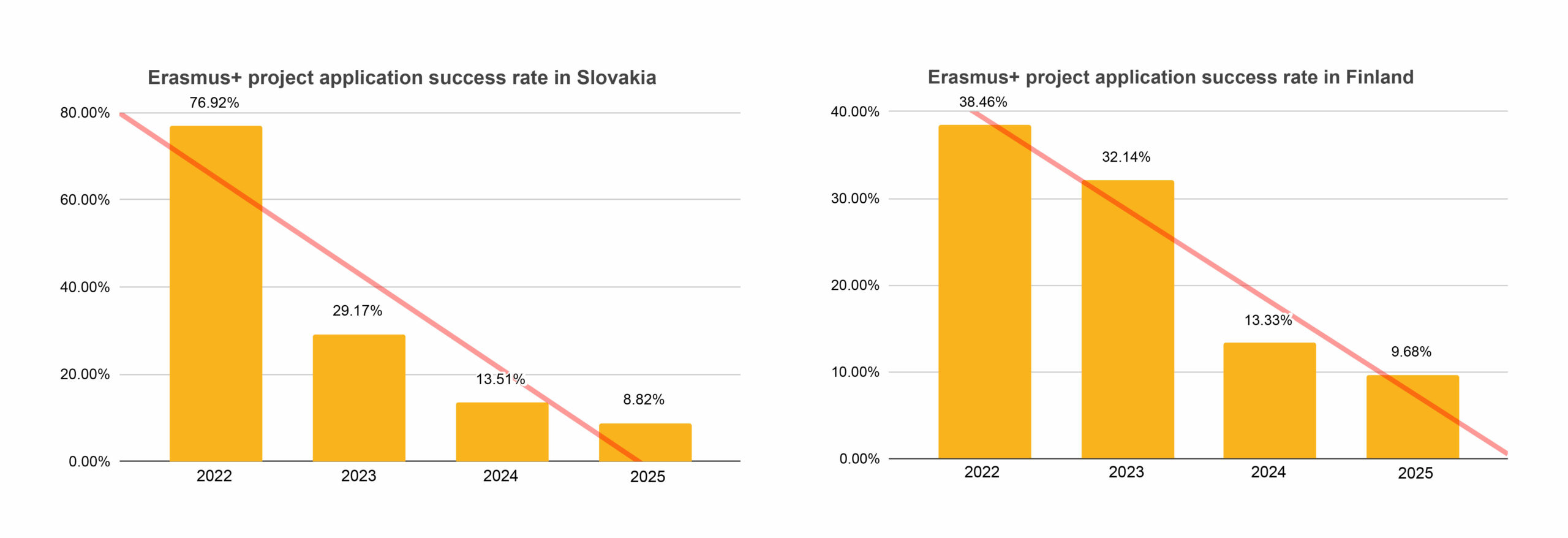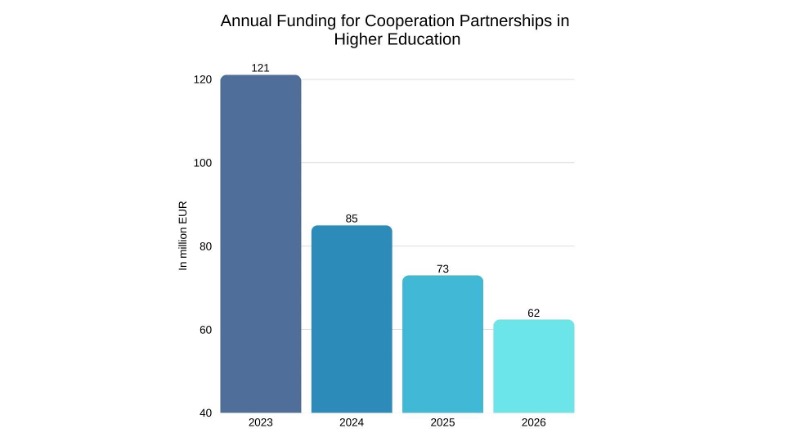Over the summer, European higher education institutions (HEIs) were finally able to read the highly anticipated findings of the Erasmus+ 2021-2027 mid-term evaluation. This report underlines the importance of Erasmus+ bottom-up Cooperation Partnerships for the internationalisation of the European Education Area:
“Evidence indicates cost-effectiveness of cooperation activities among organisations and institutions (key action 2). Cooperation partnerships and small-scale partnerships are recognised as cost-effective. The demand for funding under key action 2 is high, calling for increased budget allocation as well as for simplifying the requirements for application…”.¹
“KA2 Cooperation partnerships were ranked by NAs/EACEA survey respondents among the top three most effective actions for organisations and staff.”²
While these conclusions were welcomed by practitioners and the sector as a whole, the summer also saw the release of the results of this year’s Higher Education Cooperation Partnership project funding calls and the publication of the 2026 Erasmus+ Annual Work Programme. There is a stark disconnect between what Erasmus+ midterm evaluation considers the impact of Erasmus+ Cooperation projects to be and the reality of deepening budget cuts by the European Commission, both pointing to a rather bleak outlook for European higher education.
The 2025 situation in practice
Erasmus+ Cooperation Partnerships play an essential role in unlocking critical advances in European internationalisation, digitalisation, sustainability, and democratic resilience in higher education. Through transnational cooperation, HEIs and practitioners address gaps in the Erasmus+ programme using a bottom-up approach. Yet, despite the importance and contributions of Erasmus+ projects, the numbers speak for themselves: as shown in the graphs below, project application success rates have essentially declined in several countries.
 In Slovakia, for example, Erasmus+ Higher Education project success rates plummeted from over 75% in 2022 to less than 10% three years later. In Finland, an analogous trend can be observed, though less pronounced: Erasmus+ Higher Education project success rates have dropped from the mid-thirties to around 10%.
In Slovakia, for example, Erasmus+ Higher Education project success rates plummeted from over 75% in 2022 to less than 10% three years later. In Finland, an analogous trend can be observed, though less pronounced: Erasmus+ Higher Education project success rates have dropped from the mid-thirties to around 10%. 
Erasmus+ project applications in Spain also face a similar fate, with success rates declining year after year and falling to a meagre 9.64%. And while Poland still maintains a success rate above 10% in 2025, the reality remains clear: success rates are declining here too.
Taken together, these numbers paint a bleak picture. They highlight an alarming trend in the Union’s commitment to advancing the European Education Area. They also signal a missed opportunity for the European Union to promote its values to hundreds of thousands of individuals.
Such low success rates are comparable to – and in some cases worse than – the Horizon research projects. Under these conditions, can universities realistically be expected to continue applying for small-scale projects that require extensive preparation yet carry only a one-in-ten chance of approval? Or will they instead take a rational approach and focus their efforts on larger-scale projects with much greater financial envelopes and similar, if not higher, success rates?
A simple explanation
The decline in Erasmus+ Higher Education project success rates was foreshadowed and is a direct result of the Commission’s reduction of Key Action 2 Higher Education Cooperation Partnerships budget. This envelope has shrunk from a total of 121.1 million euros in 2023 to a mere 62.5 million euros just three years later – a 50% cut that is unprecedented and directly contradicts the assurances given at the beginning of the 2021 programming period, when the sector was promised progressive funding growth.

Erasmus+ Projects Funding decreased by 50% over three years. The graph also shows the figures of the 2026 draft proposal of the Annual Work Programme
Reaffirming the priority in the Erasmus+ programme
The decrease in Erasmus+ Higher Education project funding poses one of the biggest threats to the Europeanisation of the higher education sector. It is essential to ensure that more than 6,000 institutions retain realistic opportunities to benefit from Erasmus+ project funding lines, which are so impactful in supporting internationalisation and the European Education Area. This funding is also critical for the implementation of the European University Alliances.
Since practitioners are most severely affected by project funding cuts in their daily work, this pressing issue will be addressed on September 9th at a workshop organised by the EUF in parallel with the European Association for International Education (EAIE) conference in Gothenburg. Together, higher education institutions, NGOs, and policy-makers will discuss how far Erasmus+ projects have impacted the programme and why the European Commission cuts must be reversed.
- REPORT FROM THE COMMISSION TO THE EUROPEAN PARLIAMENT, THE COUNCIL, THE EUROPEAN ECONOMIC AND SOCIAL COMMITTEE AND THE COMMITTEE OF THE REGIONS on the interim evaluation of the 2021-2027 Erasmus+ programme and the final evaluation of the 2014-2020 Erasmus+ programme (p.10), COM(2025) 395 final.
- COMMISSION STAFF WORKING DOCUMENT EVALUATION Interim evaluation of the 2021-2027 Erasmus+ programme and final evaluation of the 2014-2020 Erasmus+ programme Accompanying the document Report from the European Commission to the European Parliament, the Council, the European Economic and Social Committee and the Committee of the Regions on the Interim evaluation of the 2021-2027 Erasmus+ programme and final evaluation of the 2014-2020 Erasmus+ programme (p.48), SWD(2025) 186 final.

